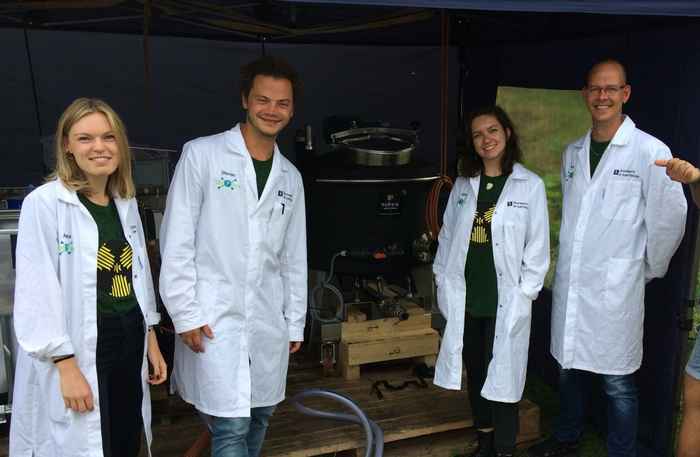Results are in from ‘We Need Your P(ee)’ at Lowlands Science
Drug and medicine residues are no obstacle to phosphate recovery
27 March 2025

Would you use this struvite as a phosphate fertiliser in agriculture, it is safe for the environment, says Slootweg: ‘The struvite is virtually free of drug and medicine residues. Only MDMA and paracetamol pose a small risk’. Fellow researcher Steven Beijer, first author of the scientific paper, explains: ‘According to our calculations, the small traces of MDMA and paracetamol in the struvite pose a low environmental risk only after about 40 years of continuous fertilisation. We therefore conclude that the struvite is in principle a useful fertiliser.’
The study, published earlier this month in the scientific journal ‘Sustainability & Circularity NOW’, also provides a nice insight into the drug use of Lowlands visitors - assuming the 1027 participants in the study are representative of the entire festival crowd. The analysis confirms the popularity of MDMA as a festival drug, and the use of cannabis, cocaine and amphetamines could also be determined. In addition, the researchers found residues of paracetamol and ibuprofen - painkillers that dampen the painful effects of excessive alcohol consumption.
The need for a sustainable phosphorus cycle
As interesting as such results are, Slootweg underpins that this was not the point of the project. His team was at Lowlands for the phosphate. It contains the element phosphorus (P), which is essential for life. Our DNA, for example, contains about ten per cent phosphorus. We absorb it from our food and the phosphorus in the food chain usually originates from phosphorus-based fertilisers.

The problem, however, is that the world's supply of phosphorus is limited. If we continue to deplete the earth's phosphorus resources for fertiliser production, we will at some point run out of the crucial element. This will disrupt the food supply and cause a global crisis.
It is therefore Slootweg's mission to realize a closed phosphorus cycle that makes us independent of the limited resources of the earth. Considering that some 15% of all the phosphorus we import into Europe (in the form of fertiliser) ‘disappears’ through the sewage system, his focus on urine becomes clear. ‘Chemically, it is not very difficult to recover phosphate from urine. You add a certain salt and a struvite precipitate forms that you can filter off. In practice it is somewhat more of a challenge, but you can already buy process equipment to obtain struvite from urine. To us the question was what else you might encounter in the struvite. Drug residues, for instance, or comparable substances. Oddly enough, there was very little information about that.’
Worst-case scenario
Participation in Lowlands Science offered the opportunity to gain more insight, Slootweg explains.
‘It was basically a worst-case scenario: the urine of festival-goers will probably contain more contaminants than you will find anywhere else. Now that our research shows that even this ‘dirty’ urine leads to clean struvite, which can be used as fertiliser, we have brought the phosphorus cycle yet another step closer.’
For Slootweg, the Lowlands project is also a great example of ‘citizen science’ where everyone can contribute to science. ‘We received a lot of interest in our project and were able to highlight the importance of closing crucial resource cycles.'
Half a hectare
It remains to be seen whether in the Netherlands it makes sense to collect urine for recovering phosphate. After all, our urine goes down the sewer and ends up at treatment plants. You might also try to recover phosphate there. ‘That is already done at some places,’ says Slootweg, ’even if it is a bit more challenging since sewage is much more diluted than urine. But for situations without sewers, it can be worth collecting urine. Think of developing countries, and of course festival settings like the one we have investigated.’ Fellow researcher Beijer adds: ‘To give an idea: if you were to process the urine produced by over 60,000 Lowlands visitors in one day, you could recover around 120 kilos of struvite. This would fertilise almost half a hectare of farmland for an entire growing season.’
Paper details
Steven Beijer, Noelia Salgueiro-Gonzalez, Sara Castiglioni, Juan C. Gerlein, Peter Scheer, G Bas de Jong, J Chris Slootweg: Phosphate Recovery at “A Campingflight to Lowlands Paradise”: Organic Micropollutant Uptake and Environmental Risk Assessment. Sustainability & Circularity NOW 2025 02, a25398742 DOI: 10.1055/a-2539-8742